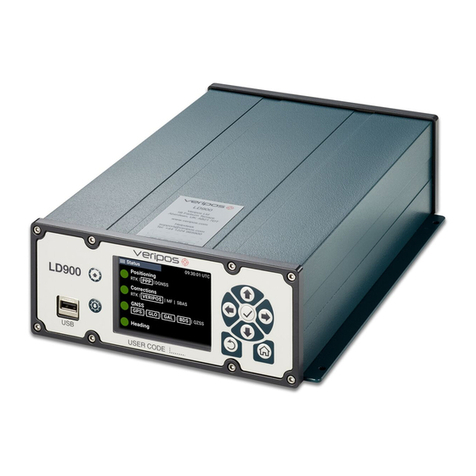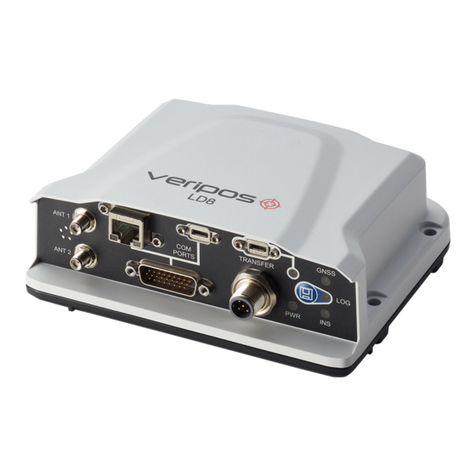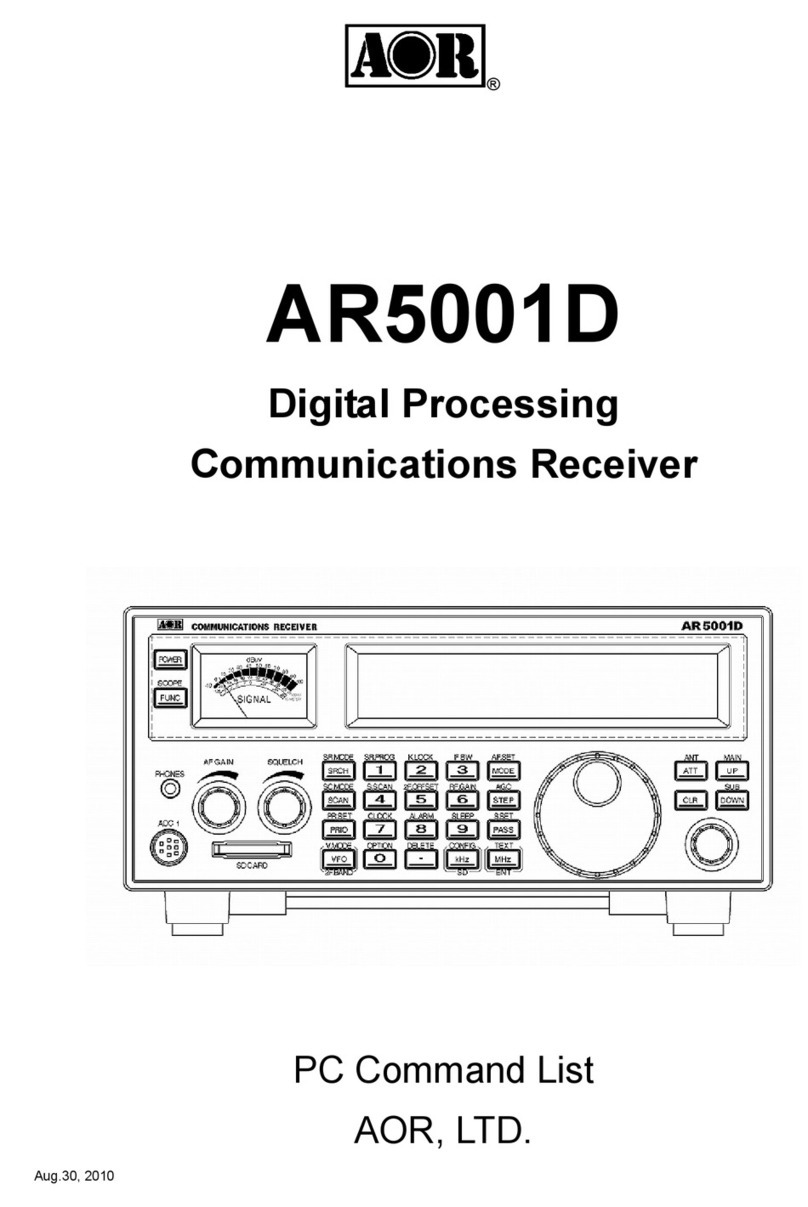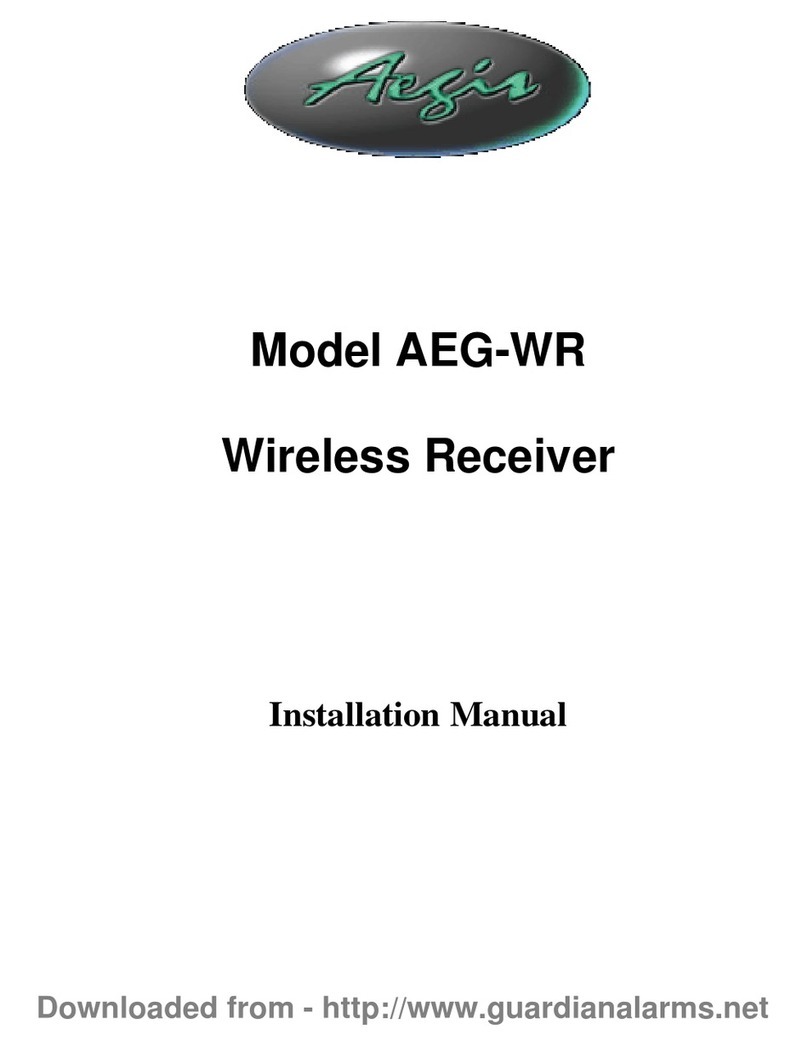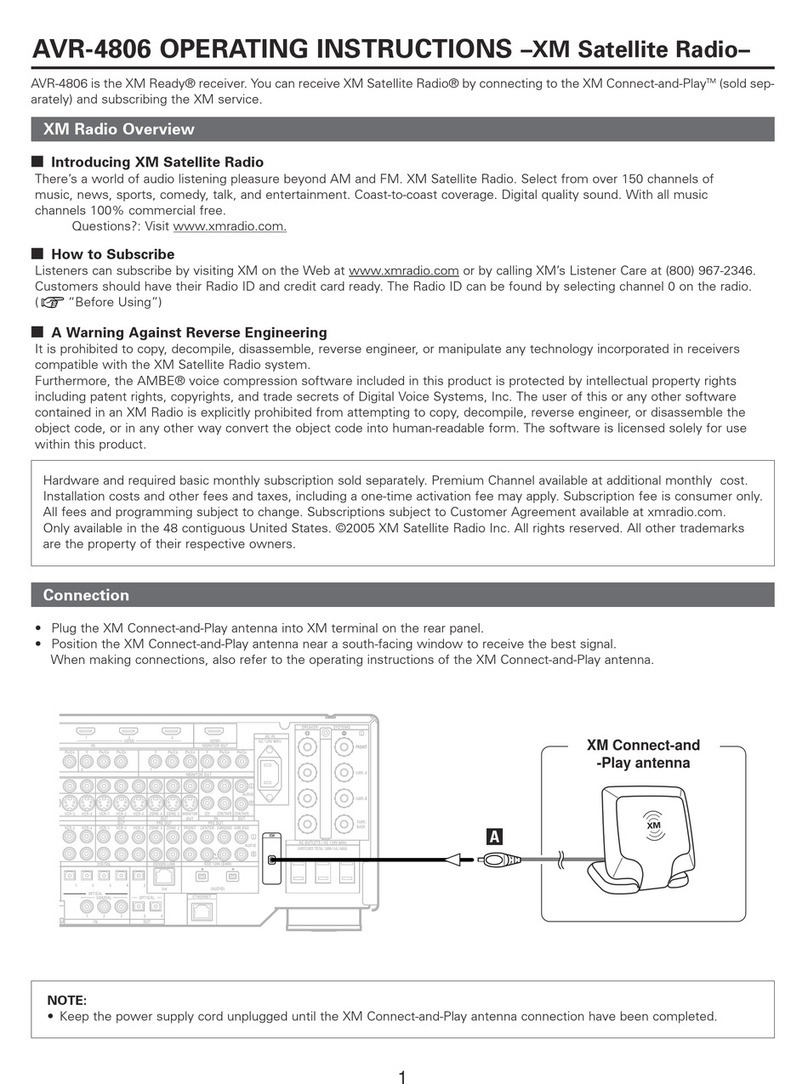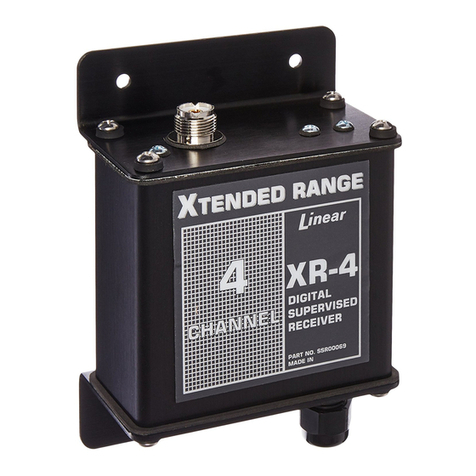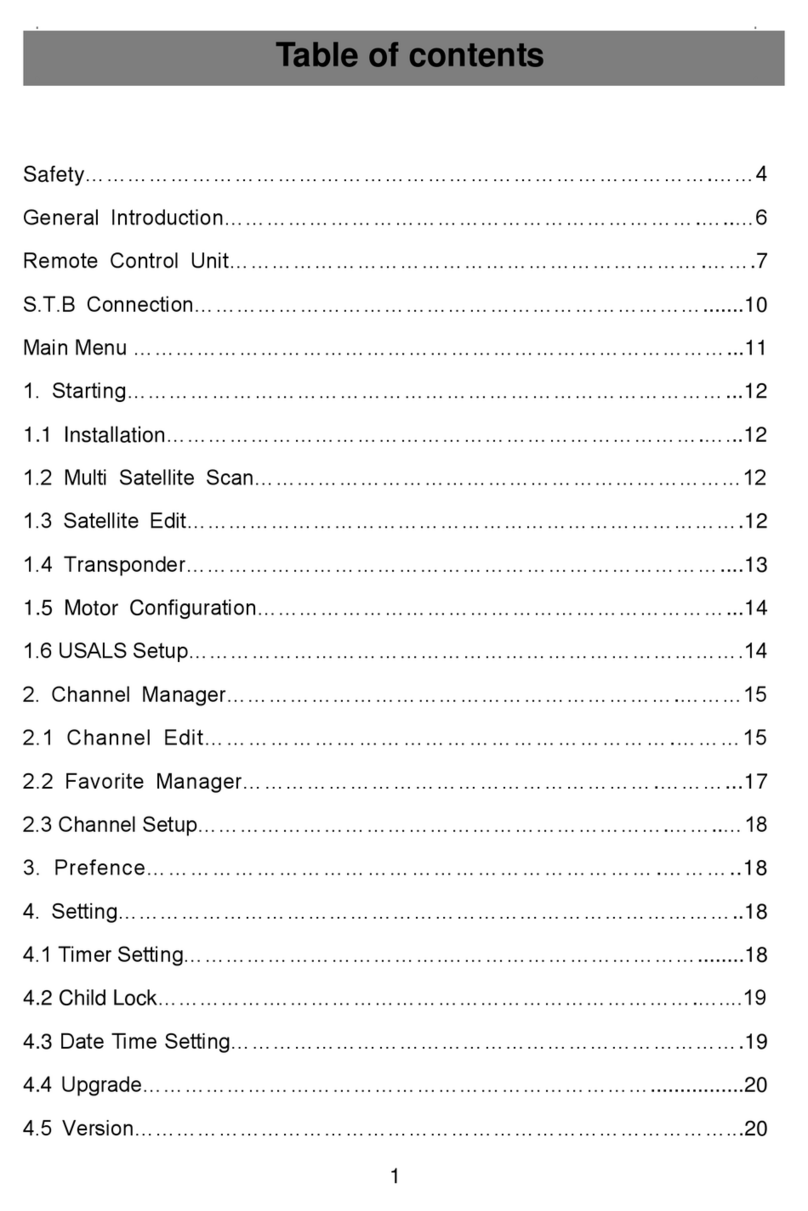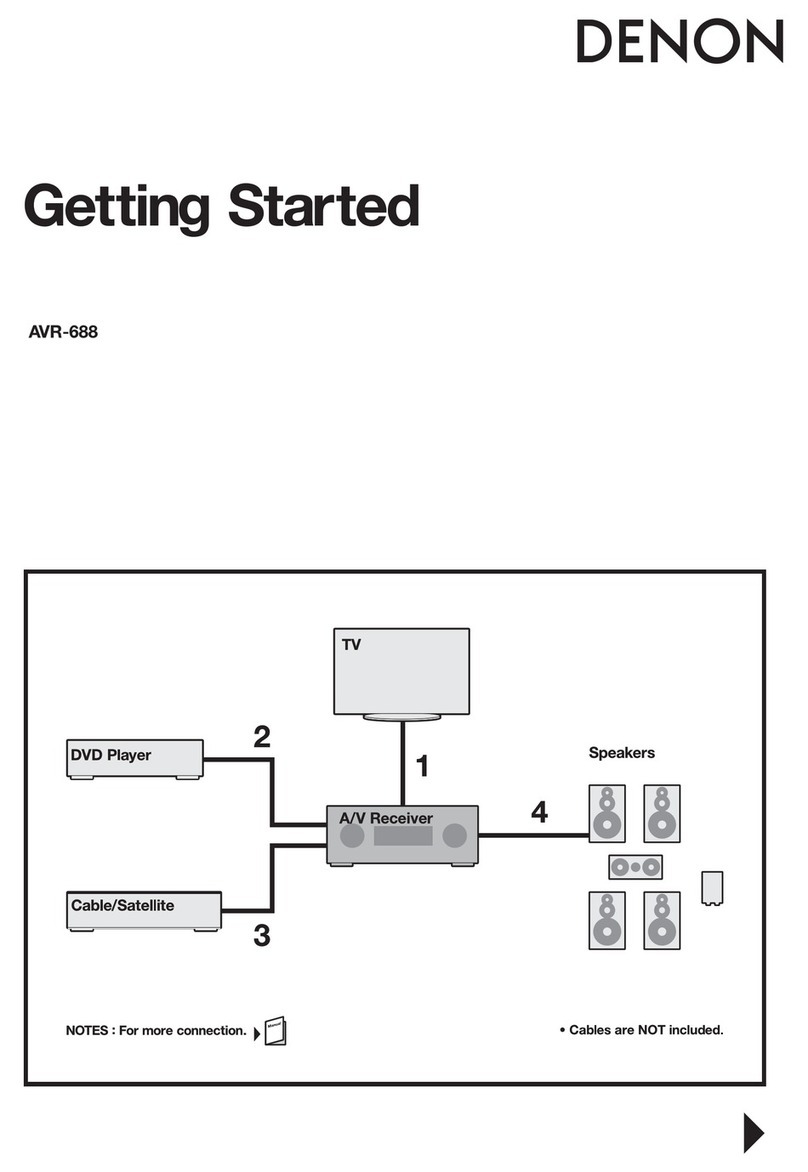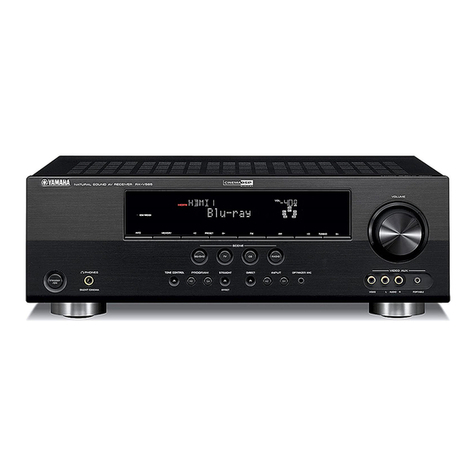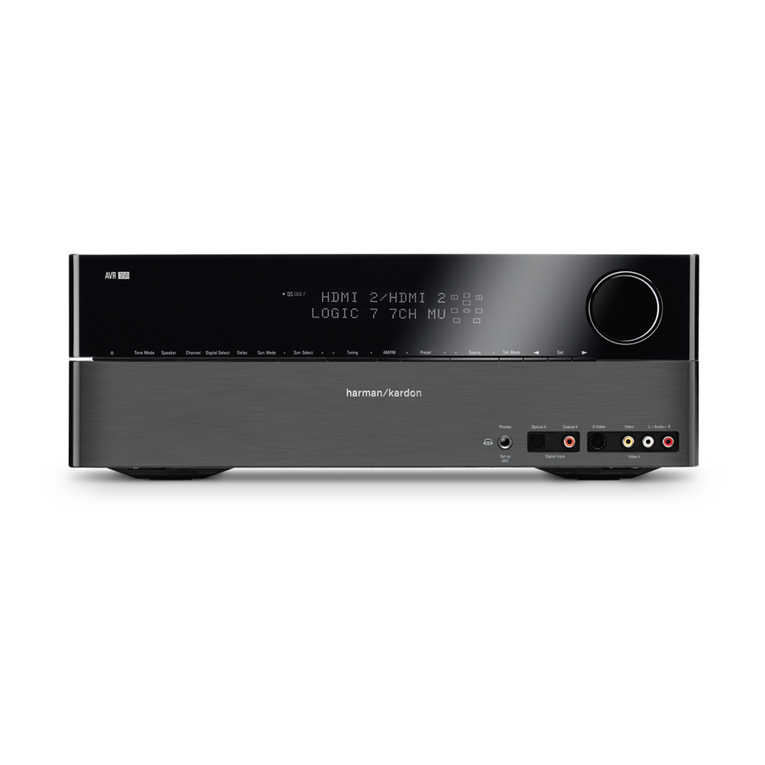Hexagon VERIPOS LD900 User manual

LD900
Installation and Operations Manual
AB-V-MA-00643_RevA8
6 February 2024

Introduction
LD900 Installation and Operations Manual 2
Contents
1Introduction..................................................................................................................................................4
1.1 General information ......................................................................................................................................4
1.2 LD900 receiver..............................................................................................................................................4
1.3 Veripos support.............................................................................................................................................5
1.4 Activating Veripos correction services..........................................................................................................5
1.5 Terms and abbreviations ..............................................................................................................................6
1.6 Document conventions .................................................................................................................................8
1.7 LD900 notices...............................................................................................................................................9
1.8 Disclaimer...................................................................................................................................................12
1.9 Equipment care...........................................................................................................................................13
2Hardware overview....................................................................................................................................14
2.1 System overview.........................................................................................................................................14
2.2 Hardware models........................................................................................................................................14
2.3 Interface and connectors ............................................................................................................................15
3LD900 installation......................................................................................................................................18
3.1 Schematic examples...................................................................................................................................18
3.2 Rack mount formats....................................................................................................................................21
3.3 LD900 location guidelines...........................................................................................................................26
3.4 LD900 mounting..........................................................................................................................................26
3.5 Ventilation requirements.............................................................................................................................27
3.6 Antenna installation.....................................................................................................................................27
3.7 Cable installation.........................................................................................................................................31
3.8 LD900 Web User Interface (WebUI)...........................................................................................................32
4Configuration and operations..................................................................................................................37
4.1 Start-up.......................................................................................................................................................37
4.2 Front panel interface...................................................................................................................................37
4.3 Menu & navigation basics...........................................................................................................................37
4.4 Status (LD900L model)...............................................................................................................................38
4.5 Status (LD900 & LD900M models).............................................................................................................38
4.7 Configuration...............................................................................................................................................43
4.8 Receiver......................................................................................................................................................64
4.9 Help & Support............................................................................................................................................69
5Troubleshooting ........................................................................................................................................70
5.1 Hardware issues.........................................................................................................................................70
5.2 Power issues...............................................................................................................................................70
5.3 Activation issues.........................................................................................................................................70

Introduction
LD900 Installation and Operations Manual 3
5.4 L-band signal issues...................................................................................................................................71
5.5 GNSS signal issues....................................................................................................................................71
5.6 Corrections issues ......................................................................................................................................72
5.7 GNSS heading issues.................................................................................................................................72
5.8 INS issues...................................................................................................................................................73
6Reference information ..............................................................................................................................74
6.1 Technical specifications..............................................................................................................................74
6.2 Cabling and connectors..............................................................................................................................76
6.3 Veripos H70 PC specifications....................................................................................................................78
6.4 LD900 output sentences.............................................................................................................................81
7Contact information ..................................................................................................................................99
7.1 Veripos Support details...............................................................................................................................99
8Appendix ..................................................................................................................................................100
8.1 Summary specification of antennas..........................................................................................................100
8.2 Summary specification of cabling .............................................................................................................102
8.3 Default system settings.............................................................................................................................104
8.4 L-band coverage map...............................................................................................................................106

Introduction
LD900 Installation and Operations Manual 4
1 Introduction
1.1 General information
This document provides the information required to install and operate the Hexagon | Veripos LD900 receiver.
To assist with LD900 installation and operation, it will help to have the following items available when consulting
this document:
•LD900 and associated equipment shipped to site.
•The Delivery note provided within the shipment.
•Antenna and Coaxial Cable Installation
•LD900 FAQs and Quick Guides, available from https://help.veripos.com.
1.2 LD900 receiver
The LD900 is a scalable integrated positioning sensor, operable as a basic L-band demodulator or configurable
to meet demanding offshore positioning requirements as a fully integrated mobile positioning unit with a multi-
frequency GNSS receiver. Key system features:
•Supports decimetre-level multi-constellation positioning with Veripos Apex and Ultra PPP solution
services
•Compatible with Veripos Quantum software
•EN60945 Marine Certified
•555 channels, multi-constellation, multi-frequency tracking
•Simultaneously track up to three L-band correction service satellites
•Features advanced signal filtering to mitigate the effects of interference and spoofing
•Supports RTK operations
•Multiple communication interfaces for easy installation
•Optional ALIGN® GNSS heading solution
•Optional SPAN® INS solution
•Optional MSK Beacon receive corrections from IALA marine radio beacon network
•Optional UHF receiver for reception of corrections
•Optional 7 Port expansion unit
•19 Inch rack mount options (for single or dual LD900 systems)
1.2.1 Preamble
The purpose of this manual is to provide the information necessary to install and operate the LD900.
This manual includes the following sections:
1. Introduction - Details the purpose of the manual, conventions and abbreviations.
2. Hardware overview - Describes the LD900 interface panel and provides technical data.
3. LD900 installation - Covers the installation of the LD900 and provides antenna & cabling guidelines.
4. Configuration and operations - Details system configuration and operations via the MMI.
5. Troubleshooting - Provides steps to rectify system issues that a user may encounter.
6. Reference information - Provides detailed technical specifications.
7. Contact information - Contains contact information for Veripos Support.
8. Appendix - Provides additional supplementary material.

Introduction
LD900 Installation and Operations Manual 5
1.3 Veripos support
Veripos Support is a service provided as the first point of contact for all Veripos technical support and fault
reports. It is available 24 hours a day, 365 days per year. For contact details, see the Contact information
section, on the LD900 product label located on the top of the unit or the LD900 MMI Help & Support page.
For support cases, contact support.veripos@hexagon.com or raise a ticket at https://help.veripos.com. Either
method will immediately notify Veripos Support, who will then assist.
Veripos Support will provide initial help and may, if necessary, escalate tickets to regional on-call engineers to
provide more in-depth technical support.
To aid support, upon first contact, please provide the following:
•Details of the issue or question
•Vessel name
•Company name
•Telephone number
•Unit user code
•Veripos hardware type
•Veripos software type
•Operating area
•Is this issue holding up operations?
•Any other relevant information
1.4 Activating Veripos correction services
Correction services for the LD900 are provided on a subscription basis by Veripos.
Activation of the LD900 is necessary for the system to decode corrections and output a corrected position.
Users may request activation of services from Veripos Support, who will send the activation signal to the unit via
an L-band satellite.
When not in use, some service agreements may allow for service deactivation.
NOTE
To use Veripos services, a contract with Veripos must first be in place. Veripos refers to this as a Service
Access License (SAL).
To avoid delays, users should record and provide the SAL number associated with the Veripos
equipment.
Veripos Support is unable to activate any equipment unless an active SAL exists.

Introduction
LD900 Installation and Operations Manual 6
1.5 Terms and abbreviations
AC Alternating current
APEX Veripos high accuracy positioning solution
ARP Antenna reference point
AWG American wire gauge
BEIDOU Chinese commissioned GNSS
BNC A bayonet type of RF coaxial connector
C-O Computed minus observed
cm Centimetre
dB Decibel
dBuV Decibel (microVolts)
DC Direct current
DGNSS Differential GNSS
DGPS Differential GPS
DHCP Dynamic host configuration protocol
DOP Dilution of precision
DP Dynamic positioning
DQI Differential quality indicator
EN European standard
EU European Union
FCC Federal Communications Commission
GALILEO European commissioned GNSS
GLONASS Global navigation satellite system - Russian commissioned GNSS
GNSS Global navigation satellite system
GPS Global positioning system - United States commissioned GNSS
HDOP Horizontal dilution of precision
HDR High dynamic range
Hz Hertz
ID Identification
IEC International Electrotechnical Commission
IEEE Institute of Electrical and Electronics Engineers
IMU Integrated mobile unit
INS Inertial navigation system
IP Internet protocol
IPv4 Internet protocol version 4
kg Kilogram
kHz Kilohertz
lb Pound (unit of measuring weight)
LAN Local area network
L-band Signal transmitted to carry correction data to mobile users
LED Light emitting diode
LNA Low noise amplifier
MF Third party broadcasting service also referred to as 'MF' or 'Beacon'
MHz Megahertz
MM Millimetre
MMI Man machine interface
NM N-Type (male) coaxial connector
NMEA National Marine Electronics Association
NTRIP Networked transport of RTCM via internet protocol
Ohm Unit of electrical resistance
PDOP Positional dilution of precision
PPP Precise point positioning
PPS Pulse per second
PRN Pseudo random noise
PWR Power

Introduction
LD900 Installation and Operations Manual 7
RF Radio frequency
RJ45 A physical network interface standard used in telecommunications
RTCM Radio technical commission for maritime services
RTK Real-time kinematic
s Seconds
SAL Serial access license
SAL M12 Sensor actor line
SBAS Satellite based augmentation system
Standard Veripos single frequency DGPS system
SV Space vehicle
TCP Transmission control protocol
TNC A threaded type of RF coaxial connector
TNCM A threaded type of RF coaxial connector (male)
UART Universal asynchronous receiver-transmitter
UI User interface
Ultra Veripos high accuracy positioning solution
UNC Unified national coarse thread
USB Universal serial bus
UTC Coordinated universal time
VAC Voltage alternating current
VDC Volts direct current
VDOP Vertical dilution of precision
VSAT Very small aperture terminal
WEEE Waste Electrical and Electronic Equipment
Wi-Fi IEEE 802.11 (wireless) standard

Introduction
LD900 Installation and Operations Manual 8
1.6 Document conventions
1.6.1 Typographical conventions
Italic or bold text is used to emphasize certain information. Italic is also used in cross-references to other parts
of the document and to other documents.
Bold text is also used for indicators and touch screen “push-buttons” commands.
Blue text is used for hyperlinking to other sections within this document or to external documents or websites.
Bold italic text is used when display screens are mentioned in text.
Monospace text is used for input/output strings to/from the device.
1.6.2 Special notices
WARNING
A warning indicates the risk of bodily harm or serious damage to the hardware.
CAUTION
A caution indicates the risk of damaging the hardware or adversely impacting the
operation of the system.
NOTE
A note contains important information to help you make better use of the system.

Introduction
LD900 Installation and Operations Manual 9
1.7 LD900 notices
The following notices apply to the LD900:
1.7.1 Waste electrical and electronic equipment
The Waste Electrical and Electronic Equipment Directive (hereinafter referred to as the “WEEE directive”)
places an obligation on EU-based manufacturers, distributors, retailers and importers to take-back electronics
products at the end of their useful life. A sister directive, RoHS (Restriction of Hazardous Substances)
complements the WEEE directive by banning the presence of specific hazardous substances in the products at
the design phase. The WEEE directive covers all Veripos products imported into the EU as of August 13, 2005.
EU-based manufacturers, distributors, retailers and importers are obliged to finance the costs of recovery from
municipal collection points, reuse, and recycling of specified percentages per the requirements contained in the
WEEE Directive.
Instructions for disposal of WEEE by users in the European Union
Products which have the undernoted symbol located on either the product itself or its packaging indicates that
the product must not be disposed of with other waste. Instead, it is the user’s responsibility to dispose of the
product by handing it over to a designated collection point for the recycling of WEEE. The symbol shown below
is on the product or on its packaging, which indicates that this product must not be disposed of with other waste.
Instead, it is the user’s responsibility to dispose of their waste equipment by handing it over to a designated
collection point for the recycling of waste electrical and electronic equipment.
The separate collection and recycling of your WEEE at the time of disposal will help to conserve natural
resources and ensure that it is recycled in a manner that protects human health and the environment. For more
information about recycling centres, please contact the local city office, the household waste disposal service or
the product supplier.

Introduction
LD900 Installation and Operations Manual 10
1.7.2 FCC
This device complies with part 15 of the FCC Rules. Operation is subject to the following two conditions: (1) this
device may not cause harmful interference, and (2) this device must accept any interference received, including
interference that may cause undesired operation.
LD900 has been tested and found to comply with the radiated and conducted emission limits for a Class B
digital device. The Class B limits are designed to provide reasonable protection against harmful interference in a
residential installation.
The equipment listed generates, uses and can radiate radio frequency energy and, if not installed and used in
accordance with the instructions, may cause harmful interference to radio communications. However, there is
no guarantee that interference will not occur in a particular installation. If this equipment does cause harmful
interference to radio or television reception, which can be determined by turning the equipment off and on, the
user is encouraged to try to correct the interference by one or more of the following measures:
•Re-orient or relocate the LD900
•Increase the separation between the equipment and the LD900
•Connect the equipment to an outlet on a circuit different from that to which the LD900 is connected
•Consult Veripos for help
CAUTION
To maintain compliance with the limits of a Class B digital device, you must use shielded interface
cables
WARNING
The LD900 has been authorised for use in mobile applications. At least 20 cm (8 inches) of separation
between the LD900 and the User must be maintained during normal operation.
WARNING
Changes or modifications to this equipment, not expressly approved by Veripos could void the user’s
authority to operate this equipment.
1.7.2.1 Wi-Fi
LD900 contains a Wi-Fi radio with the following approval:
•FCC ID: Z64-WL18SBMOD (USA)

Introduction
LD900 Installation and Operations Manual 11
1.7.3 European Union / United Kingdom (UK)
1.7.3.1 Radio Equipment Directive
Veripos declares that the LD900 including its Wi-Fi transceiver is in compliance with
1. EU Directive 2014/53/EU
2. UK Regulations S.1. 2017/1206
Radio Information:
Description of Service: Wi-Fi (802.11b/g/n)
Operational Frequency: 2412 MHz to 2462 MHz
Modulation: OFDM
Rated Power: 16.38 dBm
The full text of either the UK or EU Declaration of Conformity may be obtained from Veripos upon request.
1.7.3.2 ROHS
The LD900 is in conformity with Directive 2011/65/EU of the European Parliament and of the council of 8 June
2011 on the restriction of the use of certain hazardous substances in electrical and electronic equipment.
1.7.3.3 Reach
The LD900 is compliant with Regulation (EC) No. 1907/2006 of the European Parliament and the Council of 18
December 2006 concerning the Registration, Evaluation, Authorization and Restriction of Chemicals (REACH).
The candidate list of Substances of Very High Concern (SVHC) published by the European Chemical Agency
(ECHA) is available at: https://echa.europa.eu-/candidate-list-table.

Introduction
LD900 Installation and Operations Manual 12
1.8 Disclaimer
Hexagon Autonomy & Positioning Division Proprietary Data
This document and the information contained herein are the exclusive properties of Veripos Limited, and/or their affiliates within the Hexagon
Autonomy & Positioning division (“Hexagon”).
No part of this document may be reproduced, displayed, distributed, or used in any medium, in connection with any other materials, or for any
purpose without prior written permission from Hexagon. Applications for permission may be directed to [email protected].
Unauthorized reproduction, display, distribution or use may result in civil as well as criminal sanctions under the applicable laws. Hexagon
aggressively protects and enforces its intellectual property rights to the fullest extent allowed by law.
This document and the information contained herein are provided AS IS and without any representation or warranty of any kind. Hexagon
disclaims all warranties, express or implied, including but not limited to any warranties of merchantability, non-infringement, and fitness for a
particular purpose. Nothing herein constitutes a binding obligation on Hexagon.
The information contained herein is subject to change without notice.
© Copyright 2024 Hexagon AB and/or its subsidiaries and affiliates. All rights reserved. A list of entities within the Hexagon Autonomy &
Positioning division is available at https://hexagon.com/company/divisions/autonomy-and-positioning.

Introduction
LD900 Installation and Operations Manual 13
1.9 Equipment care
1.9.1 Unpacking and inspection
Carefully unpack and inspect the equipment, verifying receipt of all major items and ancillary equipment. If any
items are missing, contact Veripos or the system supplier as soon as possible. If the equipment appears
damaged, contact Veripos for further advice ensuring to retain the original packaging. Responsibility for damage
to items returned without the use of approved packaging will not be accepted.
1.9.2 Installation
During installation:
•Ensure DC power supply is disconnected. The power connection is accessible on the unit rear.
•Secure the unit using the holes in the base plate. Position the unit to ensure ample spacing for
access to the front interface panel and adequate ventilation during normal operation.
•Route cables safely to avoid sharp edges, excessive bends and pinches.
•Only use the cables specified within this manual for interconnection of the equipment.
•Connect the equipment to the ships ground.
1.9.3 Safety warnings
Always observe the following safety precautions:
•Ensure adequate air circulation to ventilate the unit, especially to the sides, to avoid heat build-up.
•Connect only to a power supply with a voltage within the range of 12V to 24V DC.
•Always disconnect the LD900 from the power source when connecting equipment.
•Never use the equipment in damp conditions.
•Avoid excessive heat, humidity, dust or vibration.
•Do not use in proximity to dripping or splashing liquids.
•Always use the power connections supplied with the unit.
•Before replacing a fuse, disconnect the equipment from the power source.
1.9.4 Maintenance
Clean the unit using a clean, dry cloth only. Do not wet the unit or allow the penetration of water. Do not use
solvents to clean the unit.
1.9.5 Servicing
This unit contains no user-serviceable parts. Please refer all repairs to a qualified service agent or Veripos.
1.9.6 Fault diagnosis
Follow the guidance in this document to correctly install the LD900. If issues arise, firstly, check all connections
before contacting your supplier or Veripos for assistance.

Hardware overview
LD900 Installation and Operations Manual 14
2 Hardware overview
This section provides an overview of the LD900 receiver and details the physical characteristics of the system
and the different models.
2.1 System overview
The LD900 is a high precision system built into a rugged enclosure and designed to operate reliably in the most
demanding of marine environments. The LD900 is available in three separate models and is upgradable as
required to provide any Veripos positioning solutions. Key model-dependent system features include:
•Multi-channel L-band reception supporting all Veripos correction services
•Multi-constellation GNSS system with a quad-frequency capability
•Dual antenna inputs for heading
•Multiple RS232 / RS422 ports
•Dual Ethernet ports
•Front panel display UI
•Integrated data logging
•Optional INS
2.2 Hardware models
The product label on top of the LD900 will indicate the model, with the system available in three models:
Model
Receiver modules
LD900L
L-band
LD900
L-band, GNSS
LD900M
L-band, GNSS & MF
Both the LD900 and LD900M models are capable of GPS, GLONASS, BeiDou and Galileo multi-constellation
tracking. The constellations used in the calculated solutions will depend on the use of the appropriate activated
Veripos services.

Hardware overview
LD900 Installation and Operations Manual 15
2.3 Interface and connectors
TheLD900 features a 3.5” colour MMI with keys to navigate the UI, allowing user configuration and status
monitoring.
2.3.1 Front panel interface
The LD900 front panel provides a display UI, controls and USB 2.0 port for system updates and data archiving:
2.3.2 Rear panel connectors
The LD900 rear panel has several RF and data connectors for interfacing with the unit:
Label
Connector
Description
LBAND
TNC
Primary L-band antenna connector
GNSS1
TNC
Primary GNSS connector. Used to generate the receiver position and
additionally acts as Secondary L-band antenna connector.
GNSS2
TNC
Secondary GNSS antenna. Only used for GNSS heading systems to
generate a heading in relation to the GNSS1 antenna.
BEACON
TNC
MF antenna connector
PPS
BNC
1PPS output
COM1, COM2, COM3
DB9
RS-422/RS-232
AUX
DB15
UHF module connector or for use as an additional RS-422/RS-232 port
LAN1
RJ45
Ethernet network 10/100Mbps for interfacing.
LAN2
RJ45
Ethernet network 10/100Mbps for connection to Quantum
PWR
SAL M12 4 Pin
12 to 24 VDC power input

Hardware overview
LD900 Installation and Operations Manual 16
2.3.2.1 Serial ports
The LD900 has three serial ports: COM1, COM2 and COM3, accessible via 9 pin D-Type connectors and a 15-
pin D-Type AUX serial port. Refer to the Cabling and connectors section for more details.
Port
RS-232
RS-422
Galvanically
isolated
Flow control
COM1
Yes
Yes
Yes
No
COM2
Yes
Yes
Yes
No
COM3
Yes
Yes
Yes
No
2.3.2.2 1PPS output
LD900 and LD900M models can output a 1PPS (one pulse per second) signal, synced to GPS time to
external equipment for accurate time synchronisation. The PPS voltage with no load is 8V. The PPS
pulse width is configurable (1 to 500ms).
2.3.2.3 Ethernet
The LD900 has two RJ45 sockets that support Ethernet (10Base-T/100Base-TX) for configuration and interfacing
to vessel and survey systems. Both EthernetportssupportIPv4Internet layer and TCP/IP andUDPprotocols.
LAN1 of the LD900 is used for data communications and is shipped with a factory default IP address of
192.168.2.91. Configure connecting systems to use the same IP subnet. If the LD900 needs to join an existing
TCP/IP network, see the required configuration detailed in section Receiver > Network.
LAN2 of the LD900 is available for connecting to Quantum and is shipped with a factory default IP address of
192.168.2.92.
2.3.2.4 Wi-Fi
The LD900has a wireless access point, disabled by default but available via the front panel for use with potential
future developments.
2.3.2.5 USB port
The USB 2.0 port is used for software and firmware updates and exporting logged data.
2.3.2.6 Power
The systems power input is required to be 12 to 24V whenconnecting to a DC power source and 110-240 Volts
when using the approved AC/DC power supply as provided by Veripos:

Hardware overview
LD900 Installation and Operations Manual 17
CAUTION
If the voltage supplied is below the minimum specification, the receiver will automatically shut down.
If the voltage supplied exceeds the maximum specification, the receiver may be permanently damaged
and void the warranty.
The supply must be capable of providing enough current to operate the LD900.
WARNING
Only use limited power source AC/DC adapters supplied by Veripos with the product to ensure safety.
The AC/DC adapter has been tested and approved by Veripos, and the DC supply cable incorporates a
10A fuse to protect the unit.
2.3.2.7 Grounding
An M4 stud chassis grounding point is available for connection to the ships ground with a minimum gauge
24AWG wire:

LD900 installation
LD900 Installation and Operations Manual 18
3 LD900 installation
This section provides guidance on the installation of the LD900 receiver. In the event of difficulty, contact your
supplier or Veripos (support.veripos@hexagon.com).
CAUTION
The personnel responsible for installing the LD900 system must be properly trained and competent to
install electronic equipment.
WARNING
No user-accessible parts. Disconnect the GNSS antenna(s) prior to servicing the LD900. Only trained
personnel are permitted to install/service the LD900 and antennas.
3.1 Schematic examples
The schematics shown below represent three examples of antenna setup arrangement. Please be aware that
other antenna configurations are possible. For long-term installations, always contact Veripos to obtain setup
drawings specific to your installation, as these may differ from the examples below:
3.1.1 L-band demodulator installation (LD900L model)

LD900 installation
LD900 Installation and Operations Manual 19
3.1.2 Survey installation (LD900 model)
Heading Option
Independent L-band Option

LD900 installation
LD900 Installation and Operations Manual 20
3.1.3 DP installation (LD900M model)
Heading Option
Other manuals for VERIPOS LD900
2
Table of contents
Other Hexagon Receiver manuals
